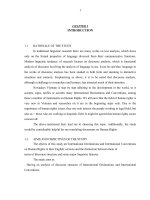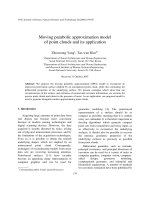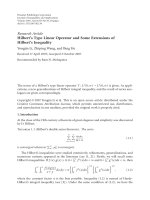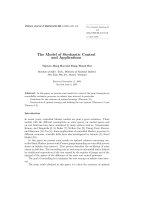model of transportation problem and some extensions
Bạn đang xem bản rút gọn của tài liệu. Xem và tải ngay bản đầy đủ của tài liệu tại đây (1.05 MB, 31 trang )
<span class="text_page_counter">Trang 1</span><div class="page_container" data-page="1">
<b>Performed by students: Truong Ngoc HuyenLecturers:</b>
<b>Dr. Ta Anh Son</b>
<b>Management information system 01 – K64</b>
<b>PROJECT I</b>
<b>INSTITUTE OF APPLICATION MATHING AND INFORMATION</b>
<b>HANOI UNIVERSITY OF TECHNOLOGY</b>
<b>Industry: Management Information Systems</b>
<b>HANOI – 2022</b>
<b>MODEL OF TRANSPORTATION PROBLEMAND SOME EXTENSIONS</b>
</div><span class="text_page_counter">Trang 2</span><div class="page_container" data-page="2"><i>Hanoi, February 6, 2022</i>
<b>2. Contents1. Goals</b>
<b>3. Evaluate the results achieved</b>
<b>TEACHER'S COMMENTS</b>
</div><span class="text_page_counter">Trang 3</span><div class="page_container" data-page="3">With the continuous development of today's world, technology tools
During my studies, I was acquainted with the subject of Economics and Mathematics
transportation accounting. With the guidance of teacher Ta Anh Son, I decided to choose
transport expands with constraints and expands according to different fields.see the need in finding optimal solutions to problems
increasingly modern but there is a fact that resources are always limited.
In the process of making the project, I have researched, learned and applied the knowledge that the teachers have equipped in the learning process. However, due to limited knowledge, this project map is inevitable
but lacking, I look forward to receiving comments from teachers to be able to improve.• Chapter 4: Work assignment problem: This chapter introduces the task division problem - is
transport models and some extended transport problems.
special case of the transport model.
• Chapter 2: Transport algorithm: After understanding the definition of the transport problem, this chapter presents the algorithms to find the starting solution and the algorithm to find the optimal solution of the transport problem.
Research the topic "Transport problem model and some extensions" with the desire to be able to understand and apply optimization methods in practice.
• Chapter 3: Extended transport problem: This chapter introduces some problemsThe layout of Project I includes 3 chapters:
• Chapter 1: Definition of the transport problem: This chapter gives the definition of the Model
Therefore, in activities with fields such as economy, education,
technology, engineering, management,. . . One must always be concerned with finding a way
the best project to achieve the goal (for each profession there will be a different goal) under certain constraints. And that is the practical application of optimization problems.
</div><span class="text_page_counter">Trang 4</span><div class="page_container" data-page="4">Through this, I would like to express my deep gratitude to Mr. Ta Anh Son, a lecturer at Hanoi University of Science and Technology, who wholeheartedly guided me so that I could complete this project.
Thank you sincerely!
<i>Hanoi, July 2022</i>
<b>Truong Ngoc Huyen</b>
</div><span class="text_page_counter">Trang 5</span><div class="page_container" data-page="5">. 222.1.1 Northwest angle method.
. 23.
. 7
. 22.
3.5 Expanded transport problems in different fields .
. 28.
.3.4 Degenerate transport problem.
. 8
.2.1 Find the starting plan for the transport model.
3.3 Transport problem of max form.
2.3 Using the monomorphic method explains the position method.
<small>3.2 The transport problem has a forbidden box.</small> .
<b>Chapter 2 Transport Algorithms</b>
.2.2 Positional method to solve transport problems.
4.2 Explain the Hungarian algorithm through the monomorphic algorithm. thirty first.
<b>Chapter 3 Extended Transport Problem</b>
<b>Table List</b>
.2.1.2 Cost minimization method.
. 9
.4.1 Hungarian Algorithm. . . .
.
</div><span class="text_page_counter">Trang 6</span><div class="page_container" data-page="6"><b>Table of symbols and abbreviations</b>
Linear ProgrammingVogel approximation method
City. Ho Chi Minh City Ho Chi Minh CityLP
</div><span class="text_page_counter">Trang 7</span><div class="page_container" data-page="7">2.3 Find the initial solution using the cost minimization method.
4.3 Steps to apply the Hungarian method to the problem of Calculus
. 15.
. 13.
. 17.
. 11
. 27.
.2.5 First distribution in VAM (x31 = 5) . . . 12 2.6 Initial alternative . . . .
4.4 Cost to assign 4 jobs to 4 children.
..2.2 The original alternative uses the Northwest method.
<i>2.7 Solve the multipliers ui and vj for the base variable . . . 14 2.8 Evaluate the out-of-base variable by the positions ui and vj . . . 14</i>
. 29.
.2.12 Iteration 2 Calculations .
.. 4
.2.11 Iteration 2 Calculations .
4.5 Opportunity Cost Matrix . . . 4.6 Apply
step 3b . . . 31 4.7 Optimal allocation scheme ..
. ten
. ten1.1 Transport problem model. . .
.2.9 Iteration 1 calculations .
. 30..
.2.1 SunRay Transport Model . . . .
2.4 Cost difference per row and column in VAM .
. 17.
.
</div><span class="text_page_counter">Trang 8</span><div class="page_container" data-page="8"><b>Table List</b>
<i>3.4 Degenerate case transport problem with dummy variable d > 0 . . . 23 3.5 </i>
Correspondence between transportation problem and inventory problem.
. 5.
.3.6 Transport model for example 2.1 .
. 17
(cost unit: thousand VND). . . 21 3.3 Degenerate case transport problem.
3.1 Transceiver unbalanced problem with Dummy Factory (cost unit)
.1.2 Transportation costs from factories to distribution centers.
. 25..
3.2 Transceiver unbalanced problem with pseudo-distribution center
. 24.
.. 22
1.1 Distance between factories and distribution centers.
.fee: thousand dong). . . 21
.
</div><span class="text_page_counter">Trang 9</span><div class="page_container" data-page="9">• Arcs represent routes linking sources and points
The goal of the model is to minimize total transportation costs while satisfying all
The transport problem model is shown in Figure 1.1 .
<small>• ARC(i,j) connects source i to destination j and contains 2 pieces of information:</small>
<i><b>– Shipping cost per cij unit .</b></i>
• There are m sources and n destinations, each represented by a node.
<i><b>– Number of shipping xij</b></i>
Figure 1.1: Transport problem model
<b>Definition of the transport problem model</b>
<b>Chapter 1</b>
</div><span class="text_page_counter">Trang 10</span><div class="page_container" data-page="10">Transport company DEF hired by ABC company is responsible for transporting the cars at a cost of 5 thousand VND per kilometer. Therefore, the cost of transporting each car on different routes is calculated as Table 1.2 (unit: thousand VND).
<small>Factory 3 1375Factory 1 1100</small>
<small>Factory 1 5500</small>
<small>Factory 3 1375</small>
<small>2790Factory 2 1350</small>
<small>Hanoi City. Ho Chi Minh City</small>
<small>Hanoi City. Ho Chi Minh City950</small>
<small>950Table 1.1: Distance between factories and distribution centers</small>
<small>Table 1.2: Transportation costs from factories to distribution centersFactory 2 1350</small>
two large distribution centers in Hanoi and Hai Phong. Quarterly capacity of three factories is 1000, 1600 and 1300 vehicles, demand at two distribution centers in the same period is 2400 and 1500 vehicles. The mileage chart between factories and distribution centers is given in Table 1.1 (unit: km).
+ x31
x21 + x22x11 + x12
<b>Example 1: Company ABC has three factories Factory 1, Factory, Factory 3 and</b>
</div><span class="text_page_counter">Trang 12</span><div class="page_container" data-page="12"><b>Chapter 2</b>
<b>Transport Algorithm</b>
This section will introduce the position algorithm to solve the transport problem. Similar to the simplex algorithm that solves linear programming problems, the displacement algorithm also derives from an initial extreme solution.
The special structure of the transport problem allows a non-profit initial solution to be secured by using one of three methods.
2. Cost minimization method1. Northwest angle method
There are several proposed methods to solve the transport problem and are divided into two categories: methods to improve the scheme (position method) and methods to gradually reduce deviation from the constraint (Hungarian method). )
A general transport model with m sources and n destinations has m + n complex equations, one for each source and each destination. However, since the transport model is always in balance (sum of supply = sum of demand) in the degenerate transport problem, one of the equations is redundant, reducing the model to m + n - 1 independent equation and m + n - 1 base variable.
<b>2.1 Find the starting plan for the transport model</b>
</div><span class="text_page_counter">Trang 13</span><div class="page_container" data-page="13">(smaller target value).
The method starts at the NW corner cell (variable x11).
• Step 2. Cross out the row or column with zero supply or demand to indicate that no more tasks can be performed in that row or column. If both a row and a column are zero at the same time, cross out one and leave zero supply (demand) in the unslashed row (column).
• Step 3. If exactly one row or column is not crossed out, stop . Otherwise, move to the right cell if a column has just been crossed out, or below if a row has been crossed out. Go to step 1.
• Step 1. Allocate as much as possible to the selected cell, and adjust the quantityrelated supply and demand by subtracting the allocated amount.
<b>2.1.1 Northwest angle method</b>
<b>2.1.2 Cost minimization method</b>
The original method is "mechanical" in nature, where its main purpose is to provide an initial (basically viable) solution regardless of cost. The other two methods are heuristics that look for a good quality initial solution
Cost minimization finds a better starting solution by targeting the cheapest routes. It assigns as much as possible to the cell with the smallest unit cost (arbitrary broken ties). Next, the matching row or column is crossed out and the supply and demand are adjusted accordingly. If
If both a row and a column are satisfied at the same time, only one column is crossed out, just like in the northwest corner method. Next, select the cell that is not crossed out
has the smallest unit cost and repeats the process until exactly one . is left
</div><span class="text_page_counter">Trang 14</span><div class="page_container" data-page="14"><b>2.1.3 Vogel approximation method (VaM)</b>
• Step 1. Determine the cell with the smallest cost and the difference between costs and costs
• Step 4. If there are multiple equal difference values, choose the uppermost value• Step 3. Determine the row/column with the largest difference. Then locate the cell with the
smallest cost corresponding to this row/column with the largest difference value and start setting this cell to the largest possible value.
<b>Example 2.1: DEF Transportation Company transports grain trucks from three silos </b>
to four factories. The supply (in terms of trucks) and demand (both in terms of trucks) along with the unit transportation cost per truck on different routes are summarized in
<i>figure 2.1. Shipping unit price, cij (shown in the NE corner of each box), in hundreds. </i>
smallest in each row, the smallest difference is written next to
</div><span class="text_page_counter">Trang 15</span><div class="page_container" data-page="15">Figure 2.2: Initial alternative using the Northwest methodFigure 2.1: SunRay Transport Model
<b>Northwest Corner Method The application of the process to produce the initial </b>
alternative is shown in Figure 2.2.The arrows show the order in which the allocated funds are generated.
The original solution was:
<i>x11 = 5.0, x12 = 10.0, x23 = 15.0, x24 = 5.0, x34 = 10.0(vehicle)</i>
The shipping cost of the above schedule is
</div><span class="text_page_counter">Trang 16</span><div class="page_container" data-page="16">There are m + n - 1 such equation that has a solution (after assigning an arbitrary position
<i>u1 = 0) producing the number of positions ui and vj . When these position numbers are </i>
<i>computed, the input variable is determined from all the out-of-base variables that are positive ui + vj ÿ cij</i>
</div><span class="text_page_counter">Trang 17</span><div class="page_container" data-page="17"><b>Chapter 3</b>
<b>Extended transport problem</b>
<i>Optimal Methods Theory and Algorithms" Assoc. Prof. Dr. Nguyen Thi Bach Kim</i>
In case the supply exceeds demand, we need to add a fake distribution center to receive the excess supply. Therefore, the cost of transporting the unit to the fake distribution center is zero. For example, assuming the demand in Hanoi is only 2000 cars, we add a dummy distribution center as shown in Table 3.2 below. this.
<i>In this chapter, the theoretical basis is used from the book "The</i>
Since demand outstrips supply, a dummy factory with a capacity of 300 vehicles (3900ÿ3600) is added to balance the model. The unit shipping cost from the dummy factory to the two distribution centers is zero because the factory doesn't exist.If the model is not balanced, a dummy source or a dummy destination must be added to restore balance.
<i>on some extended transport problems.</i>
<small>The transport model is assumed to be in equilibrium, that is, total supply equals aggregate demand.</small>
<b><small>Example 2: In Example 1, assume that Factory 2's capacity is 1300 vehicles (instead of 1600). </small></b>
<small>Total supply (= 3600 cars) is smaller than total demand (= 3900 cars), that is, part of the demand in the center of Hanoi and Ho Chi Minh City. HCM and will not be satisfied.</small>
<b>3.1 Transceiver unbalanced problem</b>
</div><span class="text_page_counter">Trang 18</span><div class="page_container" data-page="18">In practical terms, transportation problems can be affected by various factors that make it impossible to transfer goods from the ith point of origin to the jth
collection point. Then cell(i,j) is a forbidden cell and there is a transport problem with cell2790
Factory 3
2000Factory 1
Factory 2 1350
<small>Hanoi City. Ho Chi Minh City</small>
Hanoi City. Ho Chi Minh City fake distribution center
Table 3.1: Transceiver imbalance problem with fake factory (cost unit: thousand VND)
Table 3.2: Unbalanced transceiver problem with fake distribution center (cost unit: thousand VND)1600
Note that, when solving this problem, we should use the method of minimization
<b>3.2 Transport problem with forbidden cells</b>
We can also use the substitution method to solve the problem with forbidden cells by
<i>setting cij = M, where (i, j) is the forbidden box and M is an arbitrarily large positive </i>
number when comparing. This value means that we have a very heavy cost in the forbidden box (i,j), so that in the optimal solution, the cell (i,j) cannot be distributed.
</div><span class="text_page_counter">Trang 19</span><div class="page_container" data-page="19"><small>In practice, we sometimes come across a problem in the form of a transport problem, but it is necessary to</small>
<small>A degenerate extreme solution of the transport problem exists if and only if the total quantity of a supply </small>
<small>number (several table rows) is equal to the total number of rows of some row request point (a number of </small>
<small>columns). in the table). When we encounter a degenerate basic solution, we cannot perform the position </small>
<small>23 42</small>
<b>3.3 Transport problem of the form max</b>
<b>3.4 Degenerate transport problem</b>
<i>= ÿf</i>
find a way to maximize the objective function (for example, the problem of metal cutting)
<i>that is, keep the constraint and the objective function is the function f</i>
<small>more than m + n -1.</small>
<b>Example For the transport table as follows</b>
In the above transport table, there is a degenerate case because: a3 = b3 + b4 To
<i>overcome this degenerate case, we need to make sure that no partial sum of ai (supply) and bj (demand) are equal. Now, we use a dummy variable d > 0</i>
Considering the transceiver-balanced transport problem, there are m transmitters and n receivers. Then, an alternative is said to be degenerate if the selected set of cells (non-zero) has at least
</div>







